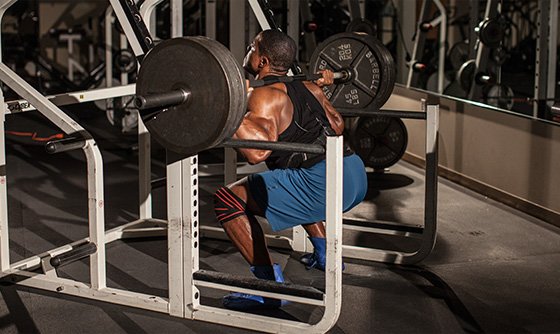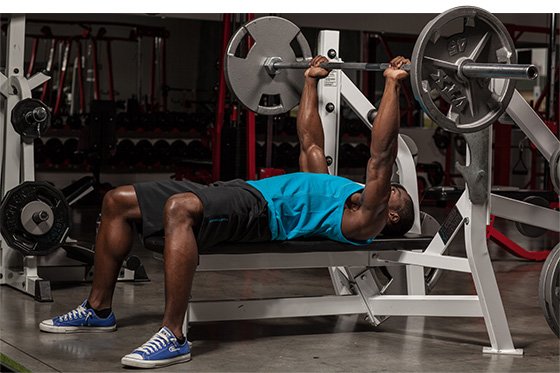I'm usually a train-and-let-train guy, but sometimes I have to strap on my armor and slay a few dragons in the name of new lifters. Myth-busting isn't just fun for sport; it's also a useful teaching tool. By debunking common myths, it's possible to learn new things and understand new perspectives.
Let's put a few fictitious beasts to rest and narrow our training focus by exposing these three common training myths!
MYTH 1: "GROWTH REQUIRES VARIETY"
It's disheartening to see a young lifter wander through a weight room and try every isolation machine in the name of "muscle confusion." One of the worst myths is that growth requires extreme exercise variation to hit a muscle from X, Y, and Z angles.

LET'S PUT A BLADE THROUGH THIS DRAGON'S HEART FOR GOOD! MUSCLES NEED TENSION AND VOLUME TO GROW.
Let's put a blade through this dragon's heart for good! Muscles need tension and volume to grow. Tension comes from weight that makes the brain, and the nervous system, recognize that it's important to use and build more muscle. It's not the result of a cornucopia of isolation exercises; it's the result of putting a heavy barbell in the hands or on the back and moving it.
To quell the inefficient "variety" method and get stronger and bigger, load a barbell heavily, not necessarily to max, and move it through enough sets to total 20-30 total reps.
To further squash the variety mindset before you're out of the gym and into an exercise circus, you need to explore the many uses of a barbell, settle on exercise variations that work, and use them repeatedly. Program jumping and constant exercise variation limit the body's ability to adapt. Despite what infomercials say, the body wants to meet the demands imposed on it, not to be confused.
Focus on a deadlift variation, a squat, a few presses, and a row, and train them like mad!
MYTH 2: "YOU MUST ISOLATE EACH MUSCLE TO MAKE IT GROW"
Doing small and minor exercises yields small and minor results. Triceps kickbacks andalternating dumbbell curls won't build upper-body mass like heavy pressing and rowing. The same rules apply to leg extensions and leg curls, which can't match squatting and deadlifting to build full-body mass.
Unless you're stepping on the Olympia stage soon, don't worry about isolated growth. I've got a few greenbacks in my wallet that will say the pros on stage didn't build their mass with minor exercises. They moved a lot of weight before they worried about sculpting anything.

UNLESS YOU'RE STEPPING ON THE OLYMPIA STAGE SOON, DON'T WORRY ABOUT ISOLATED GROWTH.
Until you're deadlifting twice your bodyweight for reps, can squat four wheels, and bench more than 300 pounds, don't worry about making your biceps pop. If you accomplish these goals and want to keep progressing and growing, train to deadlift three times your bodyweight, squat five wheels, and bench 350 pounds.
MYTH 3: "MORE IS BETTER WHEN IT COMES TO VOLUME"
A thousand sets of a thousand reps of a thousand exercises—it's a program that flexed a thousand biceps and is totally bunk. I don't know of a program set up exactly that way, but you probably know what I'm talking about. We've seen or possibly been the person that does countless reps of one exercise, moves on to a tandem of exercises, and exhibits the same behavior. It's erroneous, shameful, and unproductive.
More seems better in theory, only it's not. An overabundant exercise buffet limits training intensity by pushing volume too high. Training advancement becomes increasingly difficult with constant exercise variation and outrageous volume. Advancement comes from understanding your needs in relation to your goals and tailoring your program to meet those needs, not from a circus full of high-volume exercises.

MORE SEEMS BETTER IN THEORY, ONLY IT'S NOT. AN OVERABUNDANT EXERCISE BUFFET LIMITS TRAINING INTENSITY BY PUSHING VOLUME TOO HIGH.
It takes volume to grow—this is a tried-and-true principle&mdash:but the volume must be accompanied by appropriate training intensity. An overabundance of reps, sets, and minor exercises pulls us away from basic exercises that build strong, muscular frames. This can limit long-term progress.
PUT THEORY INTO ACTION
The workout below incorporates the points made above. It's not flashy, but you can progress on this plan for years to meet any strength or hypertrophy goal. The program includes four training days and three rest days per week. You can place the rest days according to your schedule, but it's good to include at least one rest day after two consecutive training days.
You'll only need to modify the sets, reps, and rest to cause the bodily stress you desire. After all, progression relies upon a simple understanding: No lifter is beyond the basics.




























0 comments:
Post a Comment